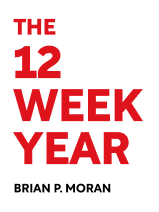

This article is an excerpt from the Shortform book guide to "The 12 Week Year" by Brian P. Moran. Shortform has the world's best summaries and analyses of books you should be reading.
Like this article? Sign up for a free trial here .
What is the Twelve Week Year? What are the five disciplines that underpin the Twelve Week Year execution system?
The Twelve Week Year is an execution planning system where the annual execution cycle is truncated within the twelve-week timeframe. It is underpinned by five disciplines: 1) create a compelling vision, 2) plan your execution, 3) control your process, 4) measure your progress, and 5) manage your time effectively.
Keep reading to learn about the five disciplines of the Twelve Week Year execution system.
What Is the Twelve Week Year?
In your personal and professional lives, you tend to set goals based on an annual plan of attack. New Year’s resolutions begin in January and aim to create the desired change by the end of the year. Likewise, organizations set productive goals annually and tend to do annual reviews of their progress. This view is called “annualized thinking” and actually hinders your progress.
Annualized thinking creates a perspective on your workflow that there is all the time in the world to meet your year-end goals. This idea becomes your mantra until you reach October, when suddenly your deadline begins to loom.
Most organizations achieve 40% of their productivity in the last 60 days of the year because of the “end-of-the-year push.” Employees suddenly become focused on only those tasks that lead to the intended results, and a new sense of urgency motivates their productive output.
But why wait a whole year to feel this heightened level of productivity? Rather than redefining your workflow at the end of the year, redefine your timeline to shorter periods to encourage high productivity every day of the year. This idea is the definition of periodization and the backbone of the Twelve Week Year execution system.
The Twelve Week Year is underpinned by five disciplines for how to create and reach your goals and maintain the right mindset as you move through the process.
Discipline 1: Create a Compelling Vision
A compelling vision is your idea of your best life. Whatever you envision for your future, whether it’s a bigger status in business, a higher income, or more satisfaction in life, your vision should be significantly greater than your current life. When you imagine a world where you have everything you want, no matter how outlandish, you’re more emotionally invested in making that future come true. And emotional investment is needed to help push through the struggles encountered along your journey to bring your future to fruition.
An emotional connection with your long-term goal encourages you to do what is necessary to achieve it. You also activate the part of your brain responsible for cognitive reasoning, and it will begin forming new pathways based on your vision. Your heightened thoughts begin the process of strengthening your beliefs, which helps quiet the part of your brain that triggers fear of change and failure.
Your vision must be big enough to activate both parts of your brain because without the fear, you won’t be pushed to achieve your greatest potential. Your compelling vision will evolve through four stages of belief:
Impossible: Your vision won’t seem reachable when you first dream it because you won’t know how to make it happen. But you don’t need to know how yet. The question to ask first is, “What if everything I wanted came true?” This question starts your neurons firing and forming pathways of possibility.
Possible: The more you continue to imagine all the benefits of your new life, the stronger your neural pathways regarding that life become. As those pathways strengthen, your belief in your dream strengthens until you feel like you could actually attain it.
Probable: After you move into believing your future is probable, you start to focus on how you can achieve it. The steps you begin to develop to achieve your vision become your plan of attack. And with a good plan, you start to truly believe your dreams will come true.
Given: You now see exactly what to do to shape your life into what you want it to be. And you believe your dream is inevitable because you can see exactly how you will get there.
How to Create a Compelling Vision
To create your vision, set three levels of goals. Your long-term goal will include the improvements you want to make in your spiritual, personal, professional, financial, and relational arenas of life. Dream big about the life you want to truly trigger your brain to react.
Once you have your long-term vision, think about what you need to accomplish over the next three years to make that dream a reality. Which objectives need to be accomplished first, and what are the steps needed to achieve those objectives? Be as specific and detailed as possible.
Finally, when you have your short-term objectives and necessary actions in place, you’re ready to set your first goal for your first 12-week plan. You should only focus on one or two goals within each three-month period, so make sure the goal you choose is appropriate as a jumping-off point to achieve the other goals down the line.
Discipline 2: Plan Your Execution
There are several advantages in the Twelve Week Year over the annual cycle. Those advantages include increased predictability, increased focus, and an improved structure in your workflow.
You create more predictability when you’re only looking three months down the line. Your plan becomes action-based because you’re able to envision exactly what you’ll need to do over the next 12 weeks, instead of making assumptions about behaviors six, eight, or 11 months from now. And your focus on one goal, rather than multiple objectives, supports this predictability.
Finally, the shorter timeframe and more narrow focus help you break down the necessary tasks into weekly, then daily, steps. Your plan becomes structured to optimize your time and energy.
Every Day Counts
Each week and day become important when you shift your focus from year-long progress to three-month progress. You know you can’t have too many unproductive weeks if you only have twelve to accomplish your goal. Therefore, you start to live more in the moment because you’re clear on which steps you need to complete that day to make progress the next day.
Write your 12-week goal and plan of achievement on paper so you can ground it in reality and refer to it when needed. Use the following criteria:
1. Make your tasks specific and measurable. Your actions need to be quantified and qualified so they can be analyzed to track your progress over the 12 weeks.
2. Keep your tasks positive. Write the goals in a way that promotes wins rather than losses. Rather than state, “Reduce errors by 25%,” write, “Increase success rate by 75%.”
3. Set tasks that stretch your abilities. Challenge yourself enough to stay motivated and execute at a high level but manageable enough to not frustrate your efforts.
4. Promote accountability. Take ownership of your process to ensure you follow through on the plan you’ve created.
5. Create deadlines. Set clear deadlines for when each task needs to be completed. Deadlines motivate you to work harder and keep you accountable.
Discipline 3: Control Your Process
A solid weekly routine is needed to guide your actions and keep track of your progress so you’re always moving in the right direction. Three aspects of process control will help you move forward on your journey to greatness: a weekly plan, peer support, and progress measures. The latter is a separate discipline and will be discussed in the following section.
The Ideal Weekly Plan
After you determine the steps required to achieve your 12-week goal, break them down into weekly goals.
Your weekly plan should clearly dictate which tasks are required daily to generate the necessary results and foundation for further progress. Take time at the beginning of each week to go over the plan, and after one week, use this time to review the progress made the week before. With a strategic schedule, you’ll never question what you should be doing, and you’ll have a sense of urgency to perform the necessary tasks because of consistent deadlines.
Peer Support
Form a peer-support group to motivate you and keep you accountable. When you know your work will be evaluated by others, you’re more likely to work harder to produce high-quality results.
Discipline 4: Measure Your Progress
You can’t know if you’re progressing toward your goal if you don’t evaluate your progress along the way. The beauty of the 12-week plan is that you don’t have to wait until the end of the year to check your progress. You’ll have this information after three months to either improve upon or build on during the next 12-week period. Furthermore, you’ll be able to see how far along in your process you are and make any necessary adjustments.
Track your performance by tallying the number of tasks you’ve successfully accomplished each week. Score your progress using two different measures: lag and lead indicators.
Lag indicators are the end results of your actions, or your main goal for the 12 weeks. Lead indicators are the actions taken to reach that goal. For instance, if you set a goal to increase your organization’s income by 12%, your percentage increases experienced each week are your lag indicators. The lead indicators for your 12% increase would be more sales calls, increased product development, or increased marketing tactics.
Both indicators help you measure how well you’re working toward your goal. If you’re not on track, you have the data needed to determine whether the problem is with the process or the execution. The following example helps clarify this process:
- To increase your company’s profits by 12%, you set weekly goals for a 1% increase. But after three weeks, your profits have only increased 2%. The lag indicator is off, so now you turn to the lead indicators. You add up the accomplished tasks and receive a score of 85% achievement. This is a high percentage of productivity, so your actions are not the problem. Now you know that you may need to set higher goals and can adjust your plans to increase production expectations.
- In contrast, if you score 50% achievement, you know you aren’t executing to the level necessary for goal achievement. With this knowledge, you can determine if the tasks for each week are realistic for you or whether you just need to focus more and work harder.
Without proper measures, you can’t get the feedback required to optimize your efforts. Don’t look at low scores as failures, but rather markers pointing to a need for improvement.
Discipline 5: Manage Your Time Effectively During the Twelve Week Year
The world is full of distractions that steal your focus from high-priority tasks. In fact, studies show that most workers lose 11 hours of productivity a week because of the time it takes to refocus after bouncing back and forth between work and distractions.
There are three blocks of time you should schedule into your weekly plan to help you stay focused: strategic, buffer, and breakout blocks.
The Strategic Block
The strategic block is one three-hour chunk of time per week dedicated to your 12-week plan. During this block, you commit to only working on priority tasks. Spend a few minutes reflecting on your vision to help sharpen your focus, and spend another few minutes reviewing your plan and progress data to see how you’re doing. The rest of the time should be put toward the necessary daily tasks to reach your weekly goal.
The Buffer Block
The buffer block is a time to work on the miscellaneous activities that disrupt your workflow. When you group these activities into one chunk of time, you reduce the frustration of constant interruptions and the time wasted when you perform these tasks at random moments. Check emails, answer phone calls, meet with employees, read the news, and respond to communications for 30 minutes to one hour once or twice a day depending on the nature of the activities.
The Breakout Block
The breakout block is a three-hour period of rest to allow your mind and spirit to rejuvenate. Rest is essential for maintaining a strong focus when you’re working. If you don’t recuperate, you’ll burn out and give up on your plan. At first, start with one breakout block a month until you’re confident you have a strong work ethic regarding your 12-week plan. After that, schedule these weekly. Take a hike, watch TV, spend time with friends and family, or engage in other activities that relax you so you can come back to work energized and focused.

———End of Preview———
Like what you just read? Read the rest of the world's best book summary and analysis of Brian P. Moran's "The 12 Week Year" at Shortform .
Here's what you'll find in our full The 12 Week Year summary :
- How to create a structured plan to rapidly accomplish goals
- Why annual goals don't work
- How to create urgency by working in 12-week increments






